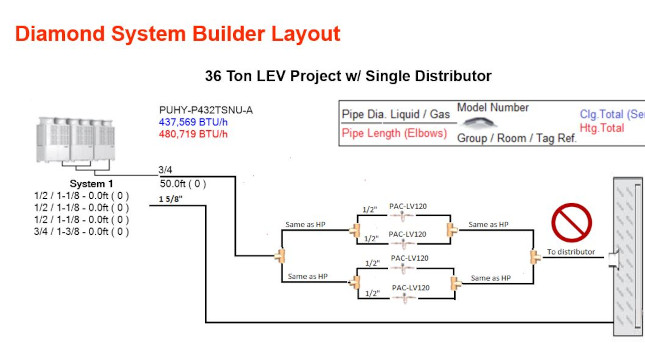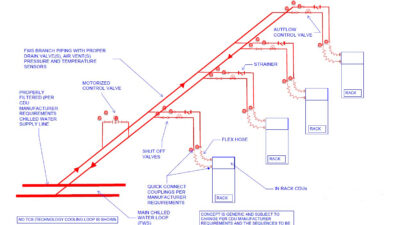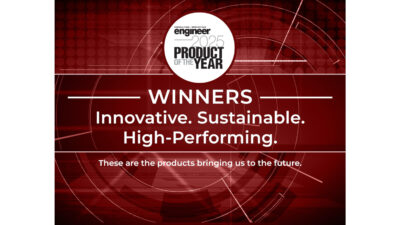In this Q&A, learn how Linear Expansion Valve (LEV) Kits help pair VRF with applied HVAC solutions for more flexibility to meet a building’s specific load, airflow, and application requirements.

A variable refrigerant flow (VRF) system is an increasingly popular choice as it provides industry-leading comfort, flexibility, high efficiency, and all-electric heating and cooling. Traditionally, VRF systems can be limited in their type and size of indoor equipment, but by using a Linear Expansion Valve (LEV) or Air Handler Expansion kit, air handler options can be expanded and provide engineers more flexibility to meet a building’s specific load, air flow, and application requirements.
LEV kits enable the advantages of the VRF outdoor system to be paired with applied equipment to get the benefits of inverter technology resulting in higher efficiency. Additionally, LEV kits can provide higher static pressure, larger capacity, customized products, and dedicated outdoor air system configurations.
Several questions were left unanswered during the July 27, 2022, webcast: Pairing VRF with applied HVAC solutions Learn more from these experts in this Q&A:
- Aaron Askew, VRF and Ductless Technical Specialist (DTS) for Indiana and central Illinois, Trane
- Evan Eitemiller, VRF and Ductless Sales Specialist for the Pacific Northwest/Rocky Mountain Region, Trane

What outdoor temperatures are the DSB blue and red heating and cooling capacities based on?
You can set the outdoor conditions specific to your design manually or you can use the ASHRAE standards for the City/State you are designing in.
Any plans for larger capacities above 20 tons?
You can now go greater than 20 Tons as long as you have multiple distributers. You would need to have multiple controllers to go larger than that 20 Tons.
You have to have a variable speed compressor?
Yes. All VRF ODUs have variable speed compressors.
Can a vrf outdoor be connected with Trane residential indoor units?
Yes, within LEV Kit design guide limits. LEV Kits are not compatible with single phase (i.e., Smart Multi, NV or P-series) ODUs. Typically, LEV kits are not approved for use with residential furnaces.
Can we combine typical VRF evaporators with LEV, non-VRF AHU’s?
Yes, within LEV Kit design guide limits.
A failed 4 pipe system have new ahu’s, can we retrofit VRF LEV kits to these units?
Yes, within LEV Kit design guide limits.
Is it possible to use LEV kits paired with a commercial AHU to become a split DOAS on a single system?
Yes, within LEV Kit design guide limits.
Recommendations for VAV applications with coil turndown? use dampers?
Yes, using bypass dampers is one potential design solution when working with minimum VAV turndown limits.
Will the controller allow control of a multi speed motor?
Yes, there are 3 discrete fan speed signals (H/M/L) that can be sent to the AHU fan controller.
When you say “distributor” does that apply to a single heating/cooling coil?
Yes, some single coils may have multiple distributors.
Having the refrigerant piping being installed correctly and as designed is critical to the performance of VRF systems. Are the piping installation tolerances as critical with LEV systems?
Yes, even more critical.
Can you list actual examples of projects that LEV kit installation?
Yes, contact your local Trane account manager.
For load conditions, can 2 smaller outdoor units be used in lieu of 1 larger one (e.g., two 10-ton vs one 20 ton?
Yes, but the DX coil is still subject to minimum airflow turndown limitations.
Can this be retrofitted into Blower coil units?
Yes, but may need a new DX coil.
Are these LEV kits compatible with both water-cooled and air-cooled outdoor units?
Yes, but LEV Kits are only compatible with 3ph ODUs. They are not compatible with Smart Multi, nor NV, P-series.
Can LEV kits be used in Multizone VAV air handlers?
Yes, as long as the coil and AHU design fit within all required specifications per the app guide (i.e., minimum fan turndown limits, etc.)
Can an LEV AHU be part of a multi-unit VRF system?
Yes, with both the Heat recovery and standard VRF heat pumps the LEV kits can be used in combination with other VRF indoor units. There are limitations such as nothing bigger than 8 tons on a Heat Recovery system due to Port Max size on the branch controller.
Cold climate, 100% OA ERU, do we need electric reheat coil downstream of the VRF coil for when the ODU goes into defrost? Assuming we cannot shut the fan off due to code reasons when the VRF coil is in defrost.
Yes, that would be best practice for when the system goes into defrost or error to prevent huge fluctuations in temperatures.
Can you provide some insight on using cassettes with a VRF and bringing in outside air to accommodate required air changes?
Yes, outside air can be brought into any of the cassettes, they all have a max value depending on size. The air cannot be raw fresh air, minimum return is 59 degrees. The Fresh air has to be forced into the cassette by another piece of equipment (DOAS, ERV, etc..) there is not enough negative pressure to draw in the air.
Can the LEV kit be controlled based on discharge air temperature? Or only space temperature?
Yes, both options are standard with the LEV kits. For discharge Air Control the minimum is a 3 Ton kit for guaranteed outputs.
Does the LEV kit require power connection?
Yes 208/230 Single Phase voltage to each LEV controller.
Will the LEV control to a heating LAT setpoint at all?
Yes.
Does the “linear” component of the title refer to capacity control of the refrigerant?
Yes.
It seems there are lot of Trane-provided tools available for engineers to do very detailed designs with these refrigerant systems. In the past other VRF suppliers have offered to do the heavy lifting with solutions for designers providing detailed selections, piping diagrams, and performance data that is unique to the project, etc. While Trane offers access these tools to designers, do Trane reps offer similar levels of support with these systems as other manufacturers?
Yes.
Is this system planned to be used with A2L refrigerants in the future?
Yes.
How do you control the system using a wireless thermostat system?
Wireless control options are N/A at this time.
Can you discuss the benefits of using VRF condensing units with LEV over traditional condensing units (like the Trane RAUJ/RAUC) in cooling only applications?
When using VRF condensing units you have the full range of the invertor compressor for better part load control, long line length applications with no additional refrigerant specialties needed. With the Y-series VRF used in cooling only you can cool down to -10 degrees ambient with the use of a low ambient cool kit.
When designing a VRF system that is going to serve an area that contains a shell space (not built out), how do we prepare the piping system handle fan coil units in the future? Valve and cap branch selector unit piping?
Using heat recovery VRF is the best way to effectively do a build out. Yes, you would valve and cap unused ports on the branch controller. The limitations to look out for are the 8-ton limit for the LEV kit on heat recovery and also that 50% of the total system capacity will need to be connected to startup the system.
I assume that the LEV kit is compatible with a retrofit of DX cooling. Would a coil for district chilled water be compatible?
Typically, LEV Kits used in retrofit applications require installation of a new DX coil as well as new piping so that contaminants from the old system do not cause premature failure of the new VRF system.
Before use of LEV Kits, how was refrigerant flow to evaporator controlled?
Traditional VRF IDUs have factory installed LEVs to meter refrigerant flow. Before LEV Kits connection to non-VRF AHUs was not allowed.
When incorporating a non-VRF air handler into as system design – how do we define the applicable characteristics of the coiling coil in DSB [like coil volume]? Or can that be done?
This cannot be done in DSB, which is why it’s recommended to use a third party coil selection software.
AHRI treats small VRF systems as mini-spits. How can I explain why a smaller VRF system can be treated as a VRF for purposes of calculating energy savings?
This all depends on the condenser capacity. For systems > 60,000 BTU/h they are tested by AHRI 1230. For systems < 60,000 BTU/h they are tested by AHRI 210/240.
One of the biggest concerns we and the building owners have is the refrigerant leaks. Do you monitor the leaks? What happens if there is a leak. Can we have redundant circuits in order not to lose the entire cooling/heating systems.
There are extensive pressure testing requirements for all VRF installations so there should not be any leaks after startup. The VRF system does not monitor for leaks. If a leak occurs, it must be found and repaired ASAP via soapy water solution applied to piping connections or with a refrigerant detector. You would need to provide redundant VRF systems in order to keep a system online in the event the other system has a leak.
How far LEV can be from VRF outdoor unit
There are different piping limitations for if the LEV is being connected to a Heat Pump or a Heat Recovery VRF system and would be specific to the manufacture but as for Trane Mitsubishi on a Heat Pump system furthest actual is 541 actual feet and 623 equivalent feet. For a Heat recovery system single branch controller max length from the Outdoor unit to the branch controller is 360 equivalent feet and from the branch controller to the LEV would be 197 equivalent feet. Always run estimated lengths through the VRF selection software to check for rules and restrictions.
Is it possible to have both a third-party thermostat interface and an MA controller connected to the same LEV kit? It is my understanding that the MA controller is needed for some programming of the LEV kit, and I don’t always have a DDC system and need the thermostat interface for some systems.
The MA controller is used and required for initial setup and configurations. It may also be used for standard space temp control. However, you cannot have both the MA controller and a third party t-stat controlling the unit in normal operation. It’s one or the other.
What is the advantage of LEV units compared to VRF units?
The LEV kit allows connection of a non-VRF AHU. Any feature that is required that is not available in a standard VRF IDU (i.e., heat wheel, higher than 1.0 ESP requirement, etc.) could be an advantageous application of an LEV Kit.
What is the advantage of installing LEV units in a typical HVAC unit?
The LEV kit allows connection of a non-VRF AHU. Any feature that is required that is not available in a standard VRF IDU (i.e., heat wheel, higher than 1.0 ESP requirement, etc.) could be an advantageous application of an LEV Kit.
Did we see that a special TEE is not recommended to twin LEV kits? It appears the twinned factory LEV kits (6,8,10T) uses a special TEE NOT a standard bull head TEE
Standard Ts are recommended. Do not use special Y-fittings, Refnet fittings, etc.
What is the most common application you are seeing LEV kits being used on?
Split DOAS applications.
How is auto mode changeover handled in a DAT application? What control inputs are needed to accomplish the change between heating and cooling?
See p. 50 of LEV Kit app guide.
We have been told minimum airflow at the VAV AHU is 80% of maximum. Why is this? This can create problems with VAV systems. Can airflows be lower but staging the LEV valves using the BAS?
See p. 47 of LEV Kit app guide.
Can the LAD be located in ceiling space below the Rooftop unit and piped up to the unit?
Probably not. The LEV valve and temp sensors have a max 16 ft wire length that cannot be extended.
Can refrigerant press connection copper fittings be used to install the LEV kits (i.e., NIBCO PressACR)?
Press fittings are allowed but not recommended. See this app guide for more detail.
Can a conventional DX AHU with a LEV be used with a VRF to use as a chilled water VAV unit would be used?
Potentially, but with more limited applications. For example, the LEV Kit may not be able to achieve as low of a LAT setpoint as with CHW. The turndown of the VAV fan may be more limited as well.
Are the details in CAD only or are they available for Revit?
only REVIT is available.
Mitsubishi / Trane provides air handlers up to 8 tons. Why use an LEV kit for the smaller air handlers?
Only if you needed some feature not available with standard VRF IDUs – i.e., heat wheel, ESP requirement > 1.0 inch etc.
I have a customer who wants a 60-80k high efficiency residential Trane furnace with a 2.5-ton Mitsubishi condenser. Would this be a good application for an LEV kit or is there a guide somewhere to help put this together?
No. LEV Kits are limited to Y and R2-series systems, which start at 6 tons and larger.
Can existing DX coils be reused in a retrofit application? (i.e., RTU with DX cooling and gas heating retrofitted with LEV kit to operate as a heat pump?)
No. A new coil would need to be used. Other systems use different oil types which could potentially contaminate the refrigerant and cause premature failure.
Can you clean the strainers?
No, the strainers are built into the LEV kit.
Can LEV kit pre-packaged in factory?
No.
What are some best practice solutions for VRF systems to comply with ASHRAE-15 if requested by client?
Limit the total system charge to be less than 26 lbs. R-410a / 1000 cu ft of occupied space. Use permanent opening between adjacent spaces to increase dilution volume of small zones.
Sorry can you clarify that the reheat coil size is maxed at 8tons or the entire lev kit?
LEV Kit applications are limited to 8 tons on a heat recovery application due to capacity limitations of the Branch Controller.
Do I need one wired controller per each LEV control box?
If using Mitsubishi wired remotes, you can group multiple LEV controllers to one Mitsubishi wired controller, similar to grouping of standard VRF IDUs. However, if using third party t-stats or BAS control, you would need one control signal per LEV control board.
On face split do you not get stratification?
Face split coils can be used for better part load capacity and dehumidification control, but could still be subject to stratification, similar to traditional face split applications.
Are LEV kits applicable to warm/hot environments CA, AZ, NV?
EAT limits for LEV Kit DX coils is 59-75 F WB in cooling and 0-59F DB in heating. The ODU is subject to the same temperature limitations as with standard VRF applications.
Any NEMA rated cabinet options for outdoor AHUs to place controller into? Or do people install inside AHU?
Dimensions of the controller are shown in the submittal. As long as it fits inside, any weather-proof enclosure would work. The controller may be able to be mounted inside the AHU as long as there is available space where it doesn’t interfere with other AHU operations. In most cases the controller gets mounted outside of the AHU.
Do you have a ballpark percentage for sensible to latent capacities in the coil?
depends on the EAT conditions.
Can the LEV kits really go up to 80 ton? It looks like the largest condenser grouping is 40 ton. So, would that be controlled by 2 condenser groups?
Correct, it would be split between 2 condensing systems most likely 4 distributers and 4 20 Ton LEV kits.
Do they require any special service clearance?
36 inches NEC clearance to high voltage connection on controller.
What is the equivalent length of a typical LEV and is the total refrigerant line length measurement include both the liquid and line piping?
16-24 inches. The pipe length input to DSB includes both pipes.
Is there any way to provide heat below 0°F ambient with these kits?
0°F is minimum EAT to LEV DX coil. Below that temp, pre-heat is required. ODUs are subject to normal temp limits.




